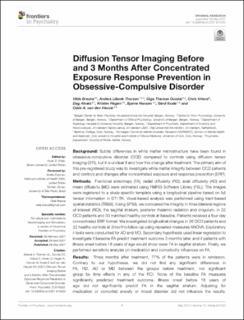| dc.contributor.author | Brecke, Vilde | |
| dc.contributor.author | Thorsen, Anders Lillevik | |
| dc.contributor.author | Ousdal, Olga Therese | |
| dc.contributor.author | Vriend, Chris | |
| dc.contributor.author | Alnæs, Dag | |
| dc.contributor.author | Hagen, Kristen | |
| dc.contributor.author | Hansen, Bjarne | |
| dc.contributor.author | Kvale, Gerd | |
| dc.contributor.author | van den Heuvel, Odile A | |
| dc.date.accessioned | 2021-12-15T11:25:24Z | |
| dc.date.available | 2021-12-15T11:25:24Z | |
| dc.date.created | 2021-06-02T11:57:55Z | |
| dc.date.issued | 2021 | |
| dc.identifier.issn | 1664-0640 | |
| dc.identifier.uri | https://hdl.handle.net/11250/2834396 | |
| dc.description.abstract | Background: Subtle differences in white matter microstructure have been found in obsessive-compulsive disorder (OCD) compared to controls using diffusion tensor imaging (DTI), but it is unclear if and how this change after treatment. The primary aim of this pre-registered study was to investigate white matter integrity between OCD patients and controls and changes after concentrated exposure and response prevention (ERP). Methods: Fractional anisotropy (FA), radial diffusivity (RD), axial diffusivity (AD) and mean diffusivity (MD) were estimated using FMRIB Software Library (FSL). The images were registered to a study-specific template using a longitudinal pipeline based on full tensor information in DTI-TK. Voxel-based analysis was performed using tract-based spatial statistics (TBSS). Using SPSS, we compared the integrity in three bilateral regions of interest (ROI), the sagittal stratum, posterior thalamic radiation and cingulum, in 32 OCD patients and 30 matched healthy controls at baseline. Patients received a four-day concentrated ERP format. We investigated longitudinal changes in 26 OCD patients and 22 healthy controls at 3months follow-up using repeated-measures ANOVA. Exploratory t-tests were conducted for AD and MD. Secondary hypothesis used linear regression to investigate if baseline FA predict treatment outcome 3 months later, and if patients with illness onset before 18 years of age would show lower FA in sagittal stratum. Finally, we performed sensitivity analysis on medication and comorbidity influences on FA. Results: Three months after treatment, 77% of the patients were in remission. Contrary to our hypotheses, we did not find any significant differences in FA, RD, AD or MD between the groups before treatment, nor significant group by time effects in any of the ROI. None of the baseline FA measures significantly predicted treatment outcome. Illness onset before 18 years of age did not significantly predict FA in the sagittal stratum. Adjusting for medication or comorbid anxiety or mood disorder did not influence the results. Conclusions: Although concentrated ERP in OCD lead to high remission, we did not find significant long-term changes by DTI. Future studies will benefit from using larger sample sizes and multi-shell diffusion-weighted imaging when investigating white matter microstructure in OCD and underlying neurobiological mechanisms of treatment. | en_US |
| dc.language.iso | eng | en_US |
| dc.publisher | Frontiers | en_US |
| dc.rights | Navngivelse 4.0 Internasjonal | * |
| dc.rights.uri | http://creativecommons.org/licenses/by/4.0/deed.no | * |
| dc.title | Diffusion Tensor Imaging Before and 3 Months After Concentrated Exposure Response Prevention in Obsessive-Compulsive Disorder | en_US |
| dc.type | Journal article | en_US |
| dc.type | Peer reviewed | en_US |
| dc.description.version | publishedVersion | en_US |
| dc.rights.holder | Copyright 2021 The Author(s) | en_US |
| dc.source.articlenumber | 674020 | en_US |
| cristin.ispublished | true | |
| cristin.fulltext | original | |
| cristin.qualitycode | 1 | |
| dc.identifier.doi | 10.3389/fpsyt.2021.674020 | |
| dc.identifier.cristin | 1913263 | |
| dc.source.journal | Frontiers in Psychiatry | en_US |
| dc.relation.project | Trond Mohn stiftelse: BFS2019TMT01 | en_US |
| dc.subject.nsi | VDP::Biologisk psykologi: 261 | en_US |
| dc.subject.nsi | VDP::Biological psychology: 261 | en_US |
| dc.subject.nsi | VDP::Biologisk psykologi: 261 | en_US |
| dc.subject.nsi | VDP::Biological psychology: 261 | en_US |
| dc.identifier.citation | Frontiers in Psychiatry. 2021, 12, 674020. | en_US |
| dc.source.volume | 12 | en_US |

